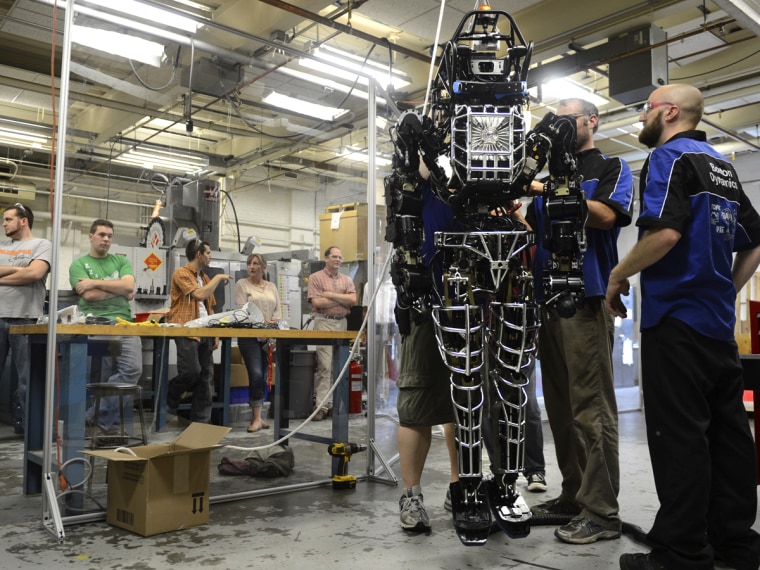Google is on a robot shopping spree, and its recent purchase of a military robot maker has some wondering what exactly the company intends to do with its own zoo of electronic creatures that creep, crawl, and climb.
It may seem odd for the Internet search giant to purchase a Boston Dynamics, a company that makes rugged machines that can run up to 29 mph, traverse rocky terrain and hurl cinder blocks up to 17 feet. The company is the eighth robot maker Google has snatched up. But the deals also indicate that the Internet giant and pioneer of self-driving cars is serious about a robot-filled future.
Other Internet-based companies are tapping into the consumer trend as well. Last year, Amazon bought Kiva Systems, to move packages in their warehouses. Earlier this month, in an announcement that raised eyebrows, Amazon CEO Jeff Bezos announced that flying delivery drones would deliver packages within five years. Meanwhile, experts and researchers anticipate that with our booming population, people may come to increasingly rely on assistive robots for elderly care.
Google's master plan remains a secret
So far, Google isn't sharing much about the purchases augmenting it's newly-launched robotics division. "It is still very early days for this, but I can't wait to see the progress," Larry Page wrote in a Google+ post, when the New York Times revealed news of the robotics operation.
Google seems to be piecing the ultimate walking, dexterous robot that can sense its surroundings — Boston Dynamics joins an assortment of newly acquired robot makers with a variety of strengths. For example, Schaft, spun off from Tokyo University, is developing a champion rescue humanoid with great balance and strong limbs, (which started out as a great pair of legs). Makers of graspers and robotics arms — Meka and Redwood Robotics are also in the mix, as are Bot and Dolly, which build robotic camera systems that were used to film "Gravity."
"I think it will be the transformation of our society — how we work, how we learn, take care of our sick, conduct our commerce, explore, handle disasters, fight wars... everything," Peter Diamandis, big-thinker and founder of the X-Prize Foundation, wrote in a Google+ post on Friday.
Mechanical monster hounds and more
Boston Dynamics tackles the challenge of locomotion on uneven turf — a hurdle to roboticists who design machines that move. Compared to existing home robots like the iRobot's floor-cleaner Roomba, Boston Dynamics' zooniverse of animal-based robots built for climbing hills, clearing walls, and surviving wars are made of some serious metal.
Started by Marc Raibert, a roboticist who taught at MIT and Carnegie Mellon University, and author of "Legged Robots That Balance," the company channels funding from DARPA and various arms of the military into a steadily expanding family of robots that can tackle almost any terrain.
BigDog, a headless four-legged monster hound is trained to hurl 35 lb cinderblocks over a distance of 17 feet, and keep its footing over very uneven turf. A record-breaker, the Cheetah robot, clocked a charging speed of 28.3 miles per hour, breaking Usain Bolt’s running time. Boston Dynamics demoed it’s successor, WildCat, this year, which can move without Cheetah's power cords, but is not quite as fast … yet. Moving on wheels rather than legs, the tiny 11-lb Sand Flea can leap up to 30 feet, easily two stories, into the air.
Boston Dynamics’ army of robotic wonder-beasts wouldn’t be complete without a sampling of two-legged human lookalikes.
PETMAN, the company’s first model, has been dry-testing safety suits for the military for a few years. But in June this year, the Boston Dynamics took the wraps off Atlas, a chunkier cousin of the PETMAN humanoid, which will compete for a future as a rescue robot in DARPA's ongoing robotics innovation contest.
"We have had a great time at Boston Dynamics, building our menagerie of robots and bringing them this far along," Marc Raibert, founder of Boston Dynamics, wrote in an email to NBC News. "Now we are excited to take the next step, to see how much further ahead we can take robotics, working with Google’s gangbuster team."
The not-so-distant future of Google robots
The possibilities are tantalizing: What can Google do with a brood of hyper-mobile galloping robots? The search-giant is already bulking up its navigation systems in the self-driving cars. For off-road exploration, with that technology added to BigDog or WildCat, isn't too much of a stretch to imagine.
Yet, several questions remain. With Google at the helm, will Raibert and BigDog be muzzled? So far, Boston Dynamics has been open, even brazen, about showing off the latest in its lineup of awe-inspiring yet fearsome machines via regularly posted YouTube videos. Founder Raibert told a gathering of roboticists at the International Robotics and Intelligent Systems conference in Tokyo in November that he tracked Boston Dynamics' YouTube view counts, and was proud of how BigDog had become an Internet sensation. Meanwhile, earlier acquisitions Meka and Redwood Robotics, have closed down their websites and retreated into stealth mode.
One thing to watch for: Will BigDog be trained not to chase after Google’s self-driving cars?
Nidhi Subbaraman writes about technology and science. You can follow her on Facebook, Twitter and Google+.
